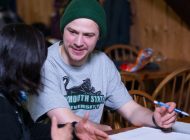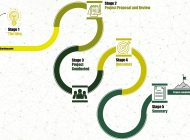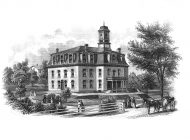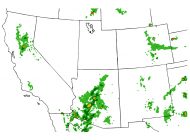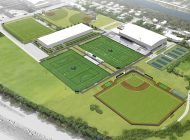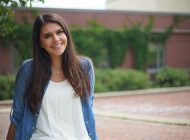Plymouth State University’s Integrated Clusters Approach
“Change is the law of life. And those who look only to the past or present are certain to miss the future,” former president John F. Kennedy once commented. This trenchant observation could easily be the rallying cry for Plymouth State President Donald Birx, who is currently leading the University through a wholesale transformation that meets the future with open arms.
Under Birx’s leadership, Plymouth State is making a dramatic shift in administration and pedagogy, moving from a traditional university model to an integrated, interdisciplinary, cluster-based model that Birx believes will give students the combination of education and engaged scholarship necessary to compete successfully in an increasingly complex and interdisciplinary world.
![]() Building on our strengths
Building on our strengths
Birx acknowledges that the undertaking is immense, encompassing both the academic and administrative aspects of the University, but he’s confident that Plymouth State is up to the challenge. “The move to integrated clusters builds on the things that Plymouth State and this region have always been good at—an interdisciplinary and integrated approach to education.” The institution has built a reputation for responding astutely to changing times and needs throughout its history, he points out. It started as a teachers college, became a training ground for business, and then morphed again into a regional, comprehensive university. “The faculty and administration have always had a remarkable ability to look to the future and envision the possibilities that lie ahead, and we’re once more on the cusp of something new. We will be on the forefront of higher education, leveraging our strengths both institutionally and regionally, and doing something really impactful by giving our students an educational experience that’s different than one they can get anywhere else.”
To understand how this wholesale transformation will take place, says Birx, think of putting together a puzzle. “I don’t start in the middle, because I don’t yet understand the framework in which pieces fit together into a coherent image. Instead, I frame the outline and build clusters of pieces that look like they go together, and lastly add the connecting pieces that draw the whole image together.”
Birx initiated the framing process a little over a year ago, shortly after he entered the president’s office in July of 2015. Now, after numerous conversations among faculty, staff, alumni, and donors, the University has identified seven academic clusters within which all degree programs will be organized: Arts & Technologies; Education, Democracy & Social Change; Exploration & Discovery; Health & Human Enrichment; Innovation & Entrepreneurship; Justice & Security; and Tourism, Environment & Sustainable Development. “These integrated clusters were picked very carefully to build on the strengths of the University as well as the region,” Birx notes. “They also recreate an integrated perspective of a liberal arts education that features engaged scholars and promotes transdisciplinary project-based learning, something I believe was lost to some extent during the last two centuries of increasing specialization and focus on discipline-based skills.”
 An ideal environment
An ideal environment
Fundamental conceptually, Birx continues, are the ideas of “Exploration & Discovery” through to “Innovation & Entrepreneurship”—the quest to explore ideas and then apply them. These concepts, which arguably are a part of each of the clusters, are highlighted here to bring together the STEM and business disciplines into the fold of a strong liberal arts education. In this context, he explains, entrepreneurship is not really a business concept, but a call to action. Those who learn to think entrepreneurially are more comfortable with risk and ambiguity and more willing to learn as they go. “It has been noted that entrepreneurs innovate because they see problems as opportunities,” Birx observes, “and there’s an openness to exploring, creating, discovering, and leading at Plymouth State that make it an ideal environment for this approach to learning.”
University environments are naturally rich settings in which to create and explore, says Birx, and Plymouth State has the added benefit of being situated in a region of abundant resources, with numerous assets available within a two-hour radius of the University. “We have individuals who have brought their expertise to this region from all over the world; they’re drawn by the natural beauty and the proximity to resources up and down the Eastern seaboard,” he notes. Many of the University’s faculty comes from richly varied backgrounds including business, industry, education, government, et cetera, making them natural proponents for the real-world learning integrated clusters entail. “We are ideally positioned to turn Plymouth State into a hotbed of activity for creative ideas and concepts,” Birx enthuses.
The University’s size also makes it well suited to the integrated clusters model. With approximately 4,100 undergraduates and 2,000 graduate students, Plymouth State is large enough to support such an integrated approach to learning, while at the same time small enough to make the structural changes necessary to facilitate the interconnected nature of the enterprise. Organizing the institution around integrated clusters will not only encourage exchanges across academic disciplines, but also streamline administrative processes and empower those closest to the points where decisions need to be made.
To guide students through the new integrated cluster approach to education, we are discussing four tools: a first-year seminar, open laboratories, themed general education, and an integrative capstone project. The first-year seminar would engage incoming students with an introduction to the cluster learning process by posing a ‘challenge’ that must be solved through cross-disciplinary work with students in other disciplines and possibly with individuals from the community, including those in business, industry, and non-profits. Project-based learning can take place in open laboratories, spaces that encourage interactions among students, faculty, and staff as well as practitioners and those interested in the application of entrepreneurial ideas to real-world challenges.
Additionally, first-year students are being assigned success coaches who will guide them in mapping out a program of study within their chosen discipline as well as hopefully identifying four to five cluster areas that will provide breadth and key skills to help them along their chosen career path. For example, a freshman might enter the University seeking an arts degree and over the course of four years take a series of general education courses that span the Arts & Technologies cluster such as writing, digital media, gaming, or graphic design; or a course sequence in Innovation and Entrepreneurship, and/or sustainability and resiliency. At the end of four years, the student would complete a capstone project to solve a challenge and demonstrate what has been learned over the past four years. “Our goal is for students to find their passion while at the same time discovering how their interests fit in with the challenges and needs of the twenty-first century global economy,” Birx explains.
For those who may wonder if such an approach works as well in practice as in theory, Birx offers up two examples: The University of Twente in the Netherlands and Great Britain’s University of Cambridge. Twente is located in the community of Enschede, a former mill community that by the late 1950s found itself struggling in the wake of international competition. In 1961, the community countered the downturn by launching a university with a novel twist: students were required to develop a mini-business plan during their course of study and were schooled in a major, integrative business skills, and the interdisciplinary collaborations that are common to the real world. “Each time a student started a company, a tree was planted,” says Birx, “and, just 50 years later, there’s both a forest and a thriving business community. The richness of the environment is inspiring and the effects on the community have been transformational, socially and economically.”
The creative fermentation at the University of Cambridge has been similarly profound, Birx notes. “Cambridge students from a host of disciplines live, eat, and sleep together—you can have a political scientist living next to an engineer—and the opportunities for the cross-pollination of ideas are legion. In fact, Trinity College of the University of Cambridge has had 32 Nobel laureates and integrative thinkers such as Isaac Newton, Alfred Lord Tennyson, and Charles Babbage,” he observes in a rush of enthusiasm.
Enthusiastic support
Although Plymouth State’s transformation to integrated clusters is in its nascent stages—the marketing campaign officially got underway in November—initial responses have been good. The University System of New Hampshire (USNH) Board of Trustees offered a full-throated endorsement, voting unanimously to support Birx’s strategic vision. Parents and prospective students have also voiced support for the change. “I’ve had the chance to meet visiting students and their parents, explain the integrated clusters concept, and preview a couple of our new open labs, and they’ve been incredibly excited,” says Birx. “Parents and students have told me ‘This makes so much sense—this is how the world works. This is what we’ve been looking for!’”
Alumni, too, have voiced their approval for the integrated cluster model. Nick Vailas ’76, a wellness and healthcare consultant and former director of the New Hampshire Department of Health and Human Services, lauds the interdisciplinary nature of the concept and is particularly enthusiastic about the ‘Health & Human Enrichment’ cluster. “Breaking down academic silos through integrated clusters and open labs provides allied health students greater interaction with healthcare professionals and a better understanding of the continuity of patient care,” he says. “This will increase efficiencies, save time and money and, most importantly, ensure better outcomes for patients.”
Current PSU students have also had the opportunity to experience the power of the integrated cluster approach. In November of 2015, the University hosted a collaborative project based on a work of art by Christine Destrempes, founder and director of Art for Water, a nonprofit organization dedicated to raising awareness and promoting dialogue around the shrinking availability of clean water as a result of climate change, access, and commercial exploitation. Working with faculty and students, Destrempes installed 10,000 Steps: Exploring Our Footprint and Her Long Walk for Water—a piece designed to create awareness of the struggle for access to water that affects nearly 800 million people around the world—on Plymouth State’s campus. In the months leading up to the installation, students from the departments of art, environmental science and policy, and philosophy worked alongside a group of international students to formulate activities, align curricula, and develop marketing materials related to the project and to global water issues.
The results were immediate and profound. Working side by side with art students, philosophy and history major Courtney Smith ’17 discovered that adding a visual element to the learning process amplified understanding in ways she hadn’t anticipated. Working across disciplines also increased Smith’s appreciation for collaborative learning. “I’m applying to graduate schools now and have been looking for programs that are more interdisciplinary in nature than those I had previously considered,” she says.
Philosophy major Joshua Butler ’17 was similarly impacted. “It was a great experience. I found it extraordinarily beneficial to say, ‘OK, here’s what I’ve learned in the classroom, and here’s how I can apply that knowledge.’” Butler says he learned how to interact with those in other fields of study and, perhaps more importantly, realized that it was okay to ask for help, a takeaway that he characterizes as one of the most important lessons to come out of academia. “I know now that when I enter a debate, it’s not helpful to shut people down – if you listen to others and communicate in a way that’s beneficial to both parties, it’s a lot easier to resolve conflicts, a lesson I think is especially relevant in today’s society.” Butler says he also took great pride in contributing to such a massive project. “I felt as though I helped by heightening people’s awareness of water issues. I’m pursuing the study of philosophy in order to help people, and I feel as though this experience validated my choice.”
“As the project progressed and the students saw their products in relation to other students’ work, the effect of the interdisciplinary approach became clearer and energy, enthusiasm and support increased,” observes Drerup Gallery Director Cynthia Robinson. “What we learned through 10,000 Steps was that together we can assemble a deep, rich, innovative, engaging and powerful learning experience for students.”
Experiences such as these are precisely what Birx is hoping the integrated clusters model will foster. Coming from the research world, Birx says he encountered many people who were deeply engrossed in their areas of specialization and often unaware of the interplay of extradisciplinary ideas. Consequently, they were prone to making more incremental changes rather than the integrative leaps that the challenges of our increasingly complex world demand. “In order to succeed as a nation, we must champion creativity and innovation, and as a university, we must foster an environment that facilitates those qualities and allows people to synthesize information across disciplines.”
Birx acknowledges that the undertaking is large, but he is certain that the students, faculty, staff, alumni, donors, and community members who comprise PSU and its environs will rise to the occasion. In fact, he’s so confident of the collective community’s abilities to meet the challenges ahead that he has committed the University to the Climate Reality Project’s ‘100% Committed’ Campaign, pledging that by 2030, Plymouth State will be powered by 100% renewable electricity. “It’s an impossible mission, yet it’s a great cluster project for precisely that reason. These types of challenges create an incubating environment where great things can happen. The task will draw together individuals from across the University community and force us to ask, ‘How can we synthesize ideas in order to innovate successfully?’ 100% Committed offers a perfect vehicle for creating and engendering the type of thinking that the integrated clusters model is predicated upon.”
Birx is eager to get both this challenge and his bigger mission underway. “Once the concept starts to coalesce and the integrated clusters start self-reinforcing, we’ll really begin to pick up speed,” he concludes. “Witnessing the transformation to this new learning model here at Plymouth State will be like witnessing a phase change. When water changes from a liquid to a solid, crystals begin to form and then exponential growth leads to a sheet of ice—a solid, cohesive unit. It’s a perfect metaphor for the holistic, synergistic change we’re striving for in the integrated clusters approach to learning here at Plymouth State—where what each of us does reinforces everything else and where each of us has a role in the final result.”
The Center for Business and Community Partnerships
Fostering collaboration with regional partners

Students perform a Brook Trout assessment in the Ammonoosuc watershed as part of an initiative to help protect small streams, preserve wildlife habitat, and cultivate a strong stewardship ethic in the region. The project, which gave students valuable hands-on learning experience, was a joint initiative among PSU’s Center for Business and Community Partnerships, the Ammonoosuc Chapter of Trout Unlimited, and New Hampshire Fish and Game. Photo by Art Greene of Ammonoosuc Trout Unlimited.
A cornerstone of the clusters initiative is the drive to create an integrated learning environment in which PSU students can collaborate with community members to solve real-world challenges. From the time they enter the University, students will have the opportunity to work side-by-side in open laboratories with practitioners in business, industry, government, and non-profit agencies, seeking solutions that benefit both the University and the region.
At Plymouth State, these interactions are facilitated by the Center for Business and Community Partnerships (CBCP), which supports collaborative and reciprocal relationships among students, faculty, and an off-campus network of industry partners from both the commercial and not-for-profit sectors. By linking PSU faculty and students with external partners, the CBCP fosters initiatives that have significant intellectual, social, cultural, scientific, and economic outcomes.
According to CBCP Director Ben Amsden, community enthusiasm for the clusters initiative is high. “This semester the center has received 70 external inquiries and is currently facilitating active partnerships involving 103 organizations, 190 students, and 22 faculty/staff.” Organizations that are currently partnering with PSU include the Appalachian Mountain Club, the New Hampshire Electric Co-op, the New Hampshire Department of Resources and Economic Development, and the White Mountain National Forest.
“The clusters initiative is incredibly exciting,” says Grafton Regional Development Corporation CEO Chris Wellington. “We welcome the opportunity to get Plymouth State students more engaged with the business community. Not only do we feel that hands-on experiences will prove beneficial to them, but we also believe the clusters and open laboratories have the potential to improve the workforce issues this region is currently facing. Attracting and maintaining a young workforce is one of the largest issues facing central and northern New Hampshire at the moment, so making connections between students and members of our business community is critical. I can’t wait to see new collaborative projects get underway.”–Lori Ferguson
Community members wishing to collaborate with the CBCP are encouraged to contact Ben Amsden at (603) 535-3276 or blamsden@plymouth.edu. Alumni interested in participating in the clusters learning process are invited to contact Director of Alumni Relations Rodney Ekstrom ‘09G at (603) 535-2217 or raekstrom@plymouth.edu.
Lori L. Ferguson is a freelance writer based in southern New Hampshire. She enjoys writing on lifestyle and health and wellness topics, as well as all things artistic.
Tags: academic careers challenges clusters collaborations Don Birx Donald L. Birx experiential hands-on integrated integrated clusters interdisciplinary Learning open laboratories open labs partners partnerships President Birx President Don Birx real-world transformation twenty-first century








